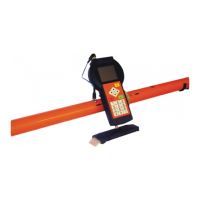Measurement time & speed of movement in the
field
The time of measurement (working like stacking) of one point can be set
in the range 0.1 s to 20 s for continuous measurement and in the range 0.2 s to 20 s
for manual measurement.
After that time new values are shown on the display. With the longer
measurement time the stability and accuracy of readings increase. The optimum
measurement time must be chosen individually according to the situation on the
locality (required accuracy, present level of electromagnetic noise).
Table with recommended measurement times with respect to noise suppression:
In continuous modes of measurement (when the instrument moves in the
field) the measured conductivity and inphase are measured as average values
measured during one measuring period. Setting of longer measuring time causes
more accurate measurement under stable conditions, but it can also cause fuzzy
edges of objects in conductivity map at higher speed of movement.
For searching for buried object the speed of movement in the field should
allow to take at least two samples over the object (e.g. for 1 m target and
measurement time 0.2 s the speed of movement should not exceed 9 km/h).
For geologic mapping the speed of movement affects density of the map
grid. Typical measurement, which uses 0.5 s measuring time and the speed of
faster walker (5 km / h), gives 70 cm grid of measured points.
CMD-Duo measuring time
CMD-Duo measuring time can be set in the range 1 s to 20 s for all types of
measurement.

